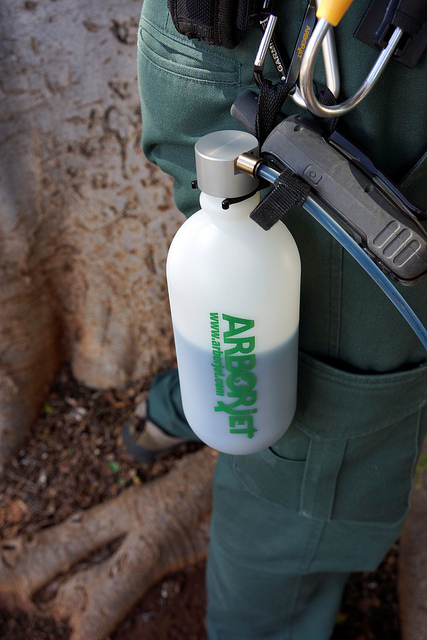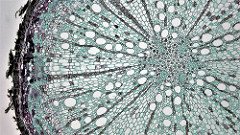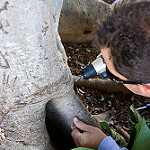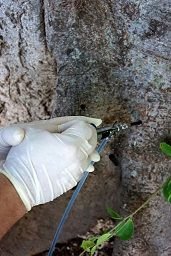IV treatment for trees. An awesome innovation and a friend to the Environment.
Have you ever been very down with an illness that makes you feel extremely weak? Or maybe like a friend of mine, you may have likely had diarrhea, or had to stool continuously for hours. You are likely to feel like you're about to pass out, of like your life is hanging in a very thin line, then you would have appreciated the common therapy for such situation, which is IV (intravenous) treatment or what many people refer to as drip.
A drip is often used to replenish lost fluid or nutrient or used to deliver medications to the body through the veins, so that it will circulate very fast and the patient will get hydrated or feel well again. This method of treatment is dated back to the 19th century, and has since been known as a medical feat to which we can all be grateful at one point or another.
This method of treatment has been found to be quite as effective in animals as it has been in humans. Yes animals, as strange as that could be, pets who gets ill or happen to loose body fluid through sickness, would require such a therapy so as to replenish the lost fluid. Dogs especially fall into this category and IV treatment has proven very effective.
So would plants be left out of the party? I guess not. So what happens when they get attacked by diseases, or become nutrient deficient, can the receive drips?
IV treatment for Plants
It is not uncommon to find trees that have lived hundreds of years, and have managed to elude the sight of deforesters, as much as it has escaped being consumed by wild fire of any sort, only to be attacked by pathogens and insects and come under danger of death.
At this point, keeping them alive becomes important as they contribute a great deal to the ecosystem. I cannot begin to enumerate the many benefits of trees to the environment, but if you wish to learn some of these importance, here is a little article for that. But I'd like to focus on the treatment of these trees.
While reading this article you may begin to wonder why those infected trees could not have just been sprayed with insecticide to kill whatever insects affects it, but let me quickly tell you that sometimes that option isn't viable due to the other effects it is likely to have on the tree itself or other nearby trees, or the adverse effect it can have on humans if such trees are close-by.
Because of some of the limitations of the many other treatment of trees, a more efficient method is to be discovered, and this is the intravenous therapy method. I can likely guess the next thing on your mind, do trees have veins? Well, the answer is NO. However, trees have xylem which practically performs the work of the veins, except that it doesn't transport blood, of course. So, what then is tree injection?

flickr.com: An Arborist in the process of administering drips to a tree
This is a treatment method used to achieve basically two things.
- To administer insecticide directly into the xylem of the trees so as to protect them from insect attack.
- To supply nutrient into the xylem of the plant whenever the tree experiences a nutrient defect.
In these two categories, one thing is common, the injection is administered into the tree in form of a drip. How do the trees manage to circulate the drip administered? Let’s take a look at the plant’s transport system.
How do trees transport food?
Very likely, the idea of photosynthesis is not totally new, and we generally understand that as a process by which plants trap their food from the sun. But how do they circulate this food to all parts of the plant?
The plant consists of millions of cells, and since cells come together to form tissues, some of these cells form the xylem and phloem. Both tissues are primarily responsible for translocation of water and nutrients. Water transpires or evaporates from the leaves creating a suction pressure around the leave which is vital in drawing up another water through the xylem tissues.
The phloem too does a similar job, taking nutrients majorly nutrients and carbohydrates, which are produced by the leaves by the process of photosynthesis to all part of the plant, and especially those part that require energy for the plant’s growth. As mentioned earlier, these two tissues operate in a way similar to the vascular system of the human body.
A knowledge of how plants transport their food would help us understand why it is important to administer insecticides through the xylem. But before discussing its advantages, let’s take a look at how injections are administered.
How the injection is administered?
There are two major categories of injections administered to the tree.
- Macro-infusion
This is a method which is used to deliver chemicals or nutrients in large proportions (up to 50 gallons), containing the active ingredients in high concentration. This method involves drilling holes in the bark of the tree to the xylem. These drilled holes are at points around the base of the tree.
- Micro-infusion
This method employs punches rather than drills on the tree and these punches are found at higher points of the trees unlike the macro-infusion and cannot be used to deliver very large amount of chemicals.
There is also the micro-infusion which is a little bit different method of application, but same or similar result is achieved.
You may want to know how you can prepare and administer injection to your tree should in case it is attacked by pathogens. Let’s take a look at a ‘do-it-yourself’ procedure.
Contact an Arborist to confirm the exact type of infection your tree has or is likely to have due to certain circumstances.
Identifying the right tree is as important as administration, this is because injecting a dead tree or a diseased tree would be of no benefit. Remember that this procedure is dependent on the ability of the xylem to perform its duty, which is also pertinent to the leaves creating suction pressures.
Certain external conditions must be met before administering the treatment. Injecting the tree during drought will yield absolutely no result, except a proper irrigation plan is in place. However, raining season remains the best time to administer it.
Ensure to know and follow the standard for injector spacing, which happens to be every 3 inches around the circumference.
Safety is not negotiable, so ensure you have PPEs (Personal Protective Equipment) on, this includes gloves and googles. The injectors and the drill bit must be disinfected and only distilled water should be used to prepare the solution to be injected
Drill bit is 11/64 bit and depth should be 1.25 inch deep, and not deeper.
You start with 3 holes so that the bit don’t get heated up and scorch the tree.
Put the diluted insecticide in the injector and insert into the drilled holes and carefully release the solution into the tree and leave the injector there for another one hour to prevent the solution from leaking out of the drilled hole.
Then redo the same for another three holes until the circumference of the tree is covered with injectors at 1.25 inch spacing.
If the above procedures are followed, you can successfully achieve treatment of your tree. But you may begin to wonder why you should go through all this stress when there are other alternative to treatment. So then let us look at some of the benefit of using the injection method of treatment.
Merits of Tree Injection
The benefit is almost immediate.
It takes a lot of time before treatment administered through spraying insecticides or treating the soil can begin to work its way into the tree system, and become effective. The intravenous injection works almost immediately, since it is carried alongside the tree’s nutrient and delivered to the entire tree in no time. And the effect is almost immediately manifested.
Immune to Weather conditions.
Tropically applied treatment can be washed away by rain or snow, even after several days of application. But the injected solutions on the other hand are immune to being washed away by rain, or other weather conditions.
Environmentally Safe
Today when the environment is exposed to a lot of pollution, we need to strive to be friendly to the environment and not contribute to pollution that endangers the ecosystem. However, most insecticide or treatment are not environmentally friendly. Spraying them on trees is not a good idea because of drift factor, which might make those chemicals land on other trees, or animals, or even humans. Delivering these chemicals directly into the tree transport system is very effective and safe for the environment.
CONCLUSION
The next time you see someone receiving drips or a drip is administered to you, do not forget that even plants get treated with drips. Trees are very important to the well-being of humans, and we need to take care of them. They have so much historical importance, and even some of them have lived hundreds of years. So I think they deserve some accolades.
REFERENCES
1
If you write STEM (Science, Technology, Engineering, and Mathematics) related posts, consider joining #steemSTEM on steemit chat or discord here. If you are from Nigeria, you may want to include the #stemng tag in your post. You can visit this blog by @stemng for more details.




Mehn, research exposes someone o. I can never imagine that happening before now. Science and wonders though!
Nice work you've done here buddy..
Why is arborist sounding like Abore 😋😂🤔
We even need them(trees) to help remove carbon dioxide from our well polluted atmosphere.
I never knew trees got IV too, thanks for this timely information.
Boss, I was amazed too when I heard it over the radio, and that spurned me to research about it
Well, you did a great job with the research as the result is an explicitly written article.
Congratulations! Your post has been selected as a daily Steemit truffle! It is listed on rank 11 of all contributions awarded today. You can find the TOP DAILY TRUFFLE PICKS HERE.
I upvoted your contribution because to my mind your post is at least 27 SBD worth and should receive 131 votes. It's now up to the lovely Steemit community to make this come true.
I am
TrufflePig, an Artificial Intelligence Bot that helps minnows and content curators using Machine Learning. If you are curious how I select content, you can find an explanation here!Have a nice day and sincerely yours,

TrufflePigEven trees?
Well, that's part of the wonders of science!
Research was made and it became possible
This is new to me. Thank you for sharing.
Thanks for taking time to read it.
This write-up is quite informative and I say 'kudos".
This is the first time I'm being exposed to a concept as this, i.e IV drips to trees, but having read through the post I can easily perceive the possibility of this treatment and its advantage over all others.
As an environmentalist, I think this is the best option we presently have to savage what is lost of the efficiency in nature, and also to alleviate the probable harm caused to man through interactions with chemicals meant to treat these live-saving trees.
Kudos, bro.
Thanks man. It is a responsibility of everyone.
Sure, it is - To create awareness and implement.
Hehehe.. This still sounds funny trees on drips?? 😂😂
I never heard of it till now after all we all get sick and maybe this sickness explains why some trees still die when they have good rainfall and good soil.
Its really great to read about it.
Thanks. Trees can grow very old. But if at some point we don't take care of them, then they die
Yea.. That is true
Awesome research here..Good to have the knowledge of this. Thanks for sharing!
Science will never seize to wow us. Who. Would have thought that intravenous therapy could be applied to plants. The fact that this will safe the ecosystem from the adverse effects of methods like chemical sprays makes it so green.
Kudos!
This is a welcomed technology....
Quite interesting.
You did justice to the post, 👍
Thanks. I do appreciate